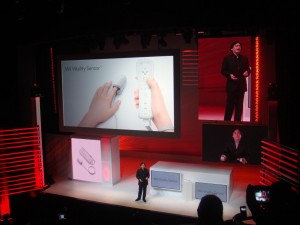Could the Wii Vitality Sensor move to Project Café?
 At Nintendo’s last investor relations meeting, an attendee pointed out that the Wii Vitality Sensor was nowhere to be seen on the company’s sales plan, and asked Iwata if it’ll be released in the next fiscal year, if ever.
At Nintendo’s last investor relations meeting, an attendee pointed out that the Wii Vitality Sensor was nowhere to be seen on the company’s sales plan, and asked Iwata if it’ll be released in the next fiscal year, if ever.
Iwata answered the question by explaining that the Vitality Sensor is “a totally new type of entertainment,” telling us that it currently only works properly with 80% of people. The folks at Nintendo being the perfectionists they are, he wants to bring that figure up to 99% before releasing it to the market.
Iwata thinks the sensor has an awful lot of interesting potential – and frankly, I do, too – and doesn’t want to give up on it. But by the sound of it, fully developing it might take quite a while – quite possibly beyond the Project Café launch. As multiple reports have shown, the Wii is definitely on its way out, and the Vitality Sensor may be better off as an unusual, attention-sparking peripheral for Café rather than yet another accessory for a console that has already saturated the market.
Do you think this is a realistic possibility?
We can deliver all the latest Wii U news straight to your inbox every morning. Want in?


There is a rumor that it will feature a Haptic screen (a kind of screen that gives feedback, so you can feel what’s shown on the screen. The rumor states it will be called Nintendo Feel
http://loading.se/news.php?pub_id=15144 (most is in Swedish, but the quotes from the source are all left in English)
– Nintendo wants to change the way we play – again. The success of Wii was essentially proof that the controller is every bit as important as graphical technology. When Nintendo unveils its next piece of hardware on June 7th, the presentation will be as much about the feel, as the look, of its new games. The revolutionary aspect will once again be found in the controller itself.
– Haptic technology is a form of tactile feedback used to simulate the experience of touching different objects shown on screen. The player can move their fingertips across a surface and clearly feel the difference between soft, smooth or rugged textures. Electronic companies across the world have been conducting research in this field for years. It’s been rumored that Apple is close to patenting a similar technology, and we’ve seen the Toshiba demonstration of ‘New Sensation UI Solution’, that applies a thin film over a screen in order to achieve a haptic effect. In Nintendo’s case, this is a natural progression of both the Nintendo DS touch screen and the Wii technology.
– You have to try Nintendo Feel to really understand. But the idea itself is very easy to sell, no matter if you are aiming for hardcore players or the wider audience that was first introduced to games through DS, Wii or Kinect.
– Remember Vitality Sensor? It will most likely make a comeback at this year’s E3, though not as a peripheral for Wii, but as a key feature of Nintendo Feel.
Yeah…
I think it would be great if Nintendo could incorporate the Vitality Sensor into the grip points of Project cafe’s controller. this way it would not be considered an accessory, which, as we know have received little support on the Wii from 3rd parties. Just look at the balance board and Wii speak. If it was directly integrated into the controller it would solve this issue and allow 3rd parties to support this feature from launch. The only factors stopping Nintendo from doing this are, accuracy and cost. If they could overcome those I think it would be a great feature.
I completely agree, John, and I’m glad someone else thought of this. The only way I could see this being applied practically with Café, though, is if it were incorperated in a future model of the controller when it would be more cost-effective to do so.
The unfortunate reality: People want to know everything a console can do right now, and everything introduced after launch day is an “overpriced, unnecessary gimmick” unless proven otherwise. Plus, developers don’t take kindly to these kinds of changes if they’re introduced too quickly and/or frequently. Need proof? Just look at the Sega Genisis/Mega Drive. In this way, consistency can be a very good thing.
What might be the best move for Nintendo is to introduce the Vitality Sensor technology into the controller of the console after Café.